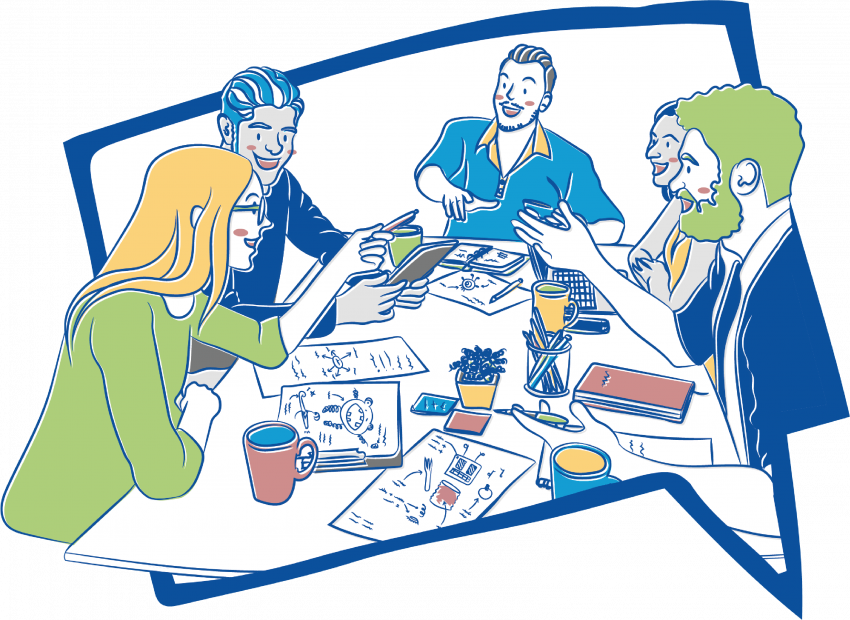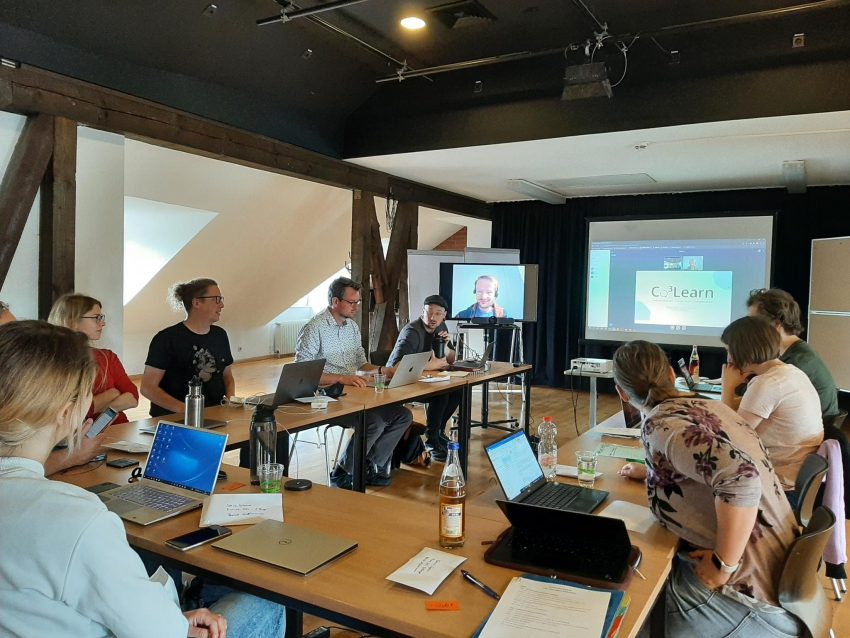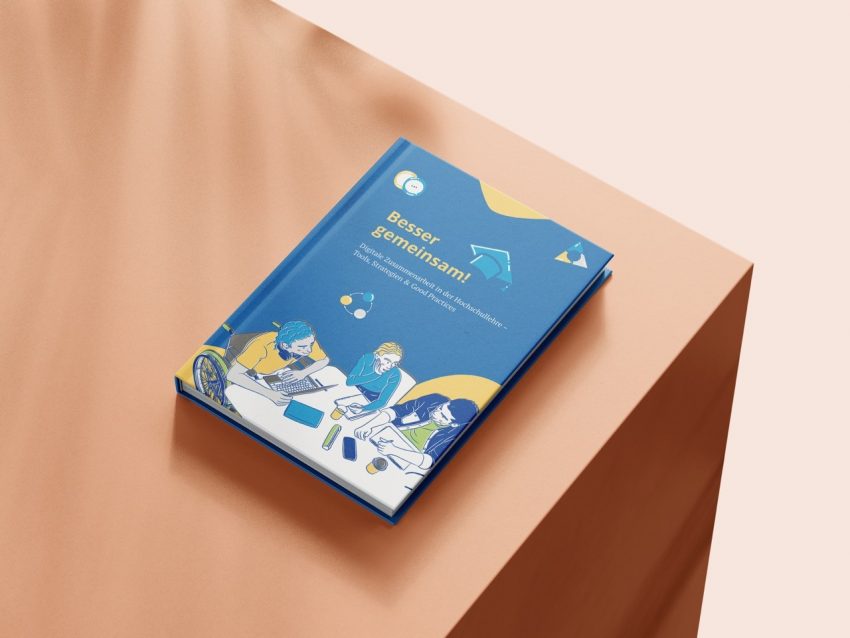Digitalisation: Good tools are not enough Rethinking collaborative teaching with Co3Learn
The Co3Learn project has transformed the way we view digital teaching and learning infrastructures, reimagining the delivery of digital tools for collaborative work across universities in close collaboration with teachers, students, and IT departments. Since the project began in 2021, one thing has become particularly clear: good tools alone are not enough. The decisive factor is how they are developed and embedded together.

Alongside several collections of illustrations from the Co3Learn project showing a variety of digital collaboration scenarios, which are available to download under a CC-BY-NC-ND (4.0) licence, further OER materials can be found on the Twillo OER Portal. Photo credit: Emily Brockmann / TU Braunschweig
Co3Learn stands for “communication”, “cooperation” and “collaboration”. It is a joint project between the universities of Braunschweig, Göttingen and Hannover and will run until December 2025. The project aims to provide digital tools and infrastructures for cooperative and collaborative learning and teaching, which can be used by students and teachers.
To this end, requirements were systematically identified and initial solutions were tested and further developed together with the target group. The outcome is not just a new tool landscape, but a new perspective on digital teaching as a malleable and collaborative process.
Digitalisation: How to best unleash the added value
A key outcome of the project thus far is the closer integration of technical infrastructure and didactic design. This is particularly evident in the further development of the Academic Cloud, provided by the Gesellschaft für wissenschaftliche Datenverarbeitung mbH Göttingen (GWDG). In this context, Co3Learn has provided impetus not only for the functional expansion of the platform, but also for the development of specific didactic application scenarios. This involves more than just the use of tools such as ownCloud, BigBlueButton or HedgeDoc. The focus is on how digital infrastructures can meaningfully support teaching and learning processes.
“It is important to find a common framework for the use of tools so that collaboration works smoothly without restricting the flexibility of individuals.” – M.Sc. Darien Tartler, TU Braunschweig, interview partner for the Co3Learn project, Source: Hochschulforum Digitalisierung
During the joint project, it became clear that digital tools only reveal their added value when they are easily accessible, can be seamlessly integrated into teaching and learning, and are coordinated at an institutional level. This interaction that is one of the key strengths of Co3Learn. Close coordination with IT departments, teachers and service providers was integral to the process from the outset. This approach promotes the sustainable anchoring of digital teaching formats at the participating universities.
“Simply handing someone a laptop is not enough. You have to design virtual work. There are so many advantages to virtual work. And if you don’t design virtual work, you’re simply missing out on these advantages.” – Dr Marie Ritter, TU Braunschweig, interview partner for the Co3Learn project, Source: Hochschulforum Digitalisierung

In the Co³Learn project, cross-location work was based on digital, hybrid and analogue meetings, agile methods, and a shared set of values. These were crucial for successfully bridging technical heterogeneity and organisational differences. Photo credit: Sophie Domann / TU Braunschweig
What experience has shown
Experience from several cross-location courses shows that collaborative learning works well when the technical infrastructure is reliable and social and communicative processes are specifically supported. Co3Learn has created the framework for this, demonstrating that location-independent teaching need not be viewed as a temporary solution. Rather, it opens up new possibilities for innovative didactic concepts.
At the same time, initial networks have been established among teachers. Micro-learning formats such as “knowledge nuggets” and targeted community building – including via the Academic Cloud Hub – have revealed a growing interest in cross-institutional and cross-location exchange. (https://www.Co3Learn.de/community/) The foundation for long-term networking has been laid. This is also due to the fact that Co3Learn has experimented with working methods based on the principles of New Work, including greater flexibility, participatory design and shared responsibility in project and teaching development.
Research, reflection and a look ahead
Alongside the practical work, the joint project also conducted research, including into the acceptance of digital tools, the impact of collaborative learning environments on learning outcomes, and the importance of technical infrastructure for effective teaching. These results are being incorporated into the project’s ongoing development.
“My goal is to use face-to-face events specifically for processes that benefit from direct presence, particularly social interactions. I use digital tools to support this, for example by moving lectures outside the classroom. So you could say that I use digital tools to enhance the face-to-face experience.” – Prof. Dr. Christian Spannagel (PH Heidelberg), interview partner for the Co3Learn project, Source: Hochschulforum Digitalisierung

The 47-page booklet “Better together – digital collaboration in higher education” offers practical tools, scenarios and materials for promoting digital collaboration. It is compact and application-oriented, and is available free of charge to teachers who email info@Co3Learn.de. Photo credit: Emily Brockmann / TU Braunschweig
Separately, the dossier “Digital Collaboration” at the Hochschulforum Digitalisierung brings together a wide range of perspectives and practical experiences from the Co3Learn project, including those of teachers, students, and partner projects, and was significantly co-designed by Co3Learn.
The path that Co3Learn has taken is not yet complete. However, one thing is already clear: digital higher education teaching reaches its full potential when it is approached as a collaborative design process. This requires space for experience, exchange and further development. The changes initiated by Co3Learn have made teaching more sustainable, dialogue-oriented and user-focused. Perhaps the most important insight of all is that digitalisation is not an end in itself, but a tool for making higher education accessible.
Links: Download area & DOI booklet
